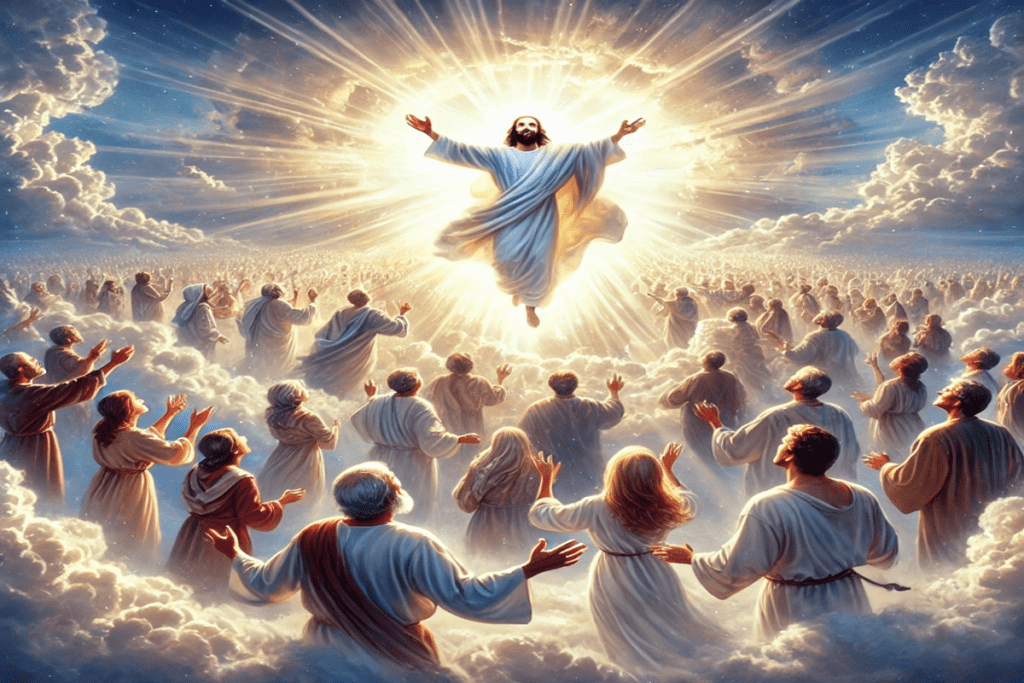Rapture an Introduction
- Rapture an Introduction
- Origins of the Word "Rapture"
- Biblical Foundations of the Rapture
- Origins of the Rapture Concept
- Differing Views on the Rapture
- Dispensational Theology View of the Rapture
- Partial Preterism and the Rapture
- Contemporary Theological Debate on the Rapture
- Rapture Conclusion
- Rapture Frequently Asked Questions
The rapture, a concept that captivates many believers, refers to the event where Christians are believed to be caught up in the air to meet Christ, preceding the end of the world as described in the Bible. This idea has sparked a wide range of interpretations and theories within the Christian community, influencing theology, eschatology, and the daily lives of believers.
In this blog post, we aim to dissect the origins of the rapture concept, tracing its development through theological discourse. We will explore various interpretations and the implications they hold for modern Christianity. Whether you’re deeply familiar with eschatological theories or newly curious about this profound topic, this post will provide a comprehensive overview of the rapture, enhancing your understanding and encouraging deeper reflection on its significance in today’s world.
Origins of the Word “Rapture”
The word rapture is imbued with a sense of profound spiritual movement and has become a cornerstone in Christian eschatology, describing the moment when believers are transported from Earth to meet Christ in the air. To fully appreciate this term, it’s essential to explore its etymological roots and theological evolution.
The term “rapture” originates from the Latin word raptus, which means “to carry away” or “to seize.” This Latin root is also the source for the English word “rapto,” reflecting a sudden and forceful action. The transformation of raptus into a theological term came through its usage in the Vulgate, the Latin translation of the Bible, particularly in the context of 1 Thessalonians 4:17. In this scripture, the Apostle Paul describes how the faithful will be “caught up” (Latin: rapiemur) together with the resurrected in the clouds to meet the Lord in the air.
The adoption of the word “rapture” to describe this scriptural event wasn’t immediate in English religious texts. The term began to gain traction in the English-speaking world much later, particularly during the 17th and 18th centuries, as scholars and theologians delved deeper into eschatological scriptures. The word was used to convey the spiritual ecstasy and divine intervention described by Paul, becoming a succinct term to encapsulate the dramatic event of Christians being swept up to heaven.
Theologically, the concept of the rapture evolved significantly with the development of various interpretative frameworks. Dispensationalism, a theological system that emerged prominently in the 19th century, particularly through the teachings of John Nelson Darby, emphasized a literal interpretation of the Bible and introduced the idea of a pre-tribulation rapture. This view posits that believers will be taken up to heaven before a period of tribulation on Earth, escaping its hardships and judgments.
As the idea of the rapture took root in modern Christian thought, it became a subject of intense debate and speculation, influencing not only theological discourse but also popular culture. Different Christian denominations have interpreted the timing and nature of the rapture in various ways, leading to a rich tapestry of belief systems centered around this anticipated event.
The word “rapture” has traveled a long path from its Latin origins to its place in modern theology. It captures a key moment of Christian eschatological expectation and continues to inspire hope, debate, and scholarly examination across the Christian world. This exploration of its linguistic and theological journey helps believers and scholars alike understand the depth and breadth of a term that promises such profound spiritual transformation.
Biblical Foundations of the Rapture
The concept of the rapture, while not explicitly named in the Bible, is derived from several key scriptures that have been interpreted to suggest such an event. This belief centers on the idea that believers will be caught up in the air to meet Christ, thereby being spared from the tribulation that is to come upon the earth.
1 Thessalonians 4:17 is the cornerstone scripture for rapture theology. It states: “Then we who are alive, who are left, will be caught up together with them in the clouds to meet the Lord in the air, and so we will always be with the Lord.” This passage is pivotal as it describes a meeting in the air with Christ, which is seen as a literal uplifting of believers. Historically, this verse did not immediately lead to the development of a rapture doctrine. Early Christian thought, particularly among the Church Fathers, tended to interpret this passage as referring to the final resurrection at Christ’s return, rather than a separate event.
Matthew 24:40-41 also contributes to rapture theology, where Jesus describes one person being taken and another left. This has been seen as suggesting a selective gathering of believers. Historically, interpretations varied widely, with some early theologians seeing it as symbolic of divine judgment rather than a literal rapture.
The development of the rapture as a distinct theological event occurred much later, particularly with the rise of dispensationalism in the 19th century. Theologians like John Nelson Darby popularized the idea that the rapture would occur separately from the Second Coming of Christ, viewing it as a pre-tribulation rescue for believers.
Revelation 3:10 is another text often cited, which promises to keep believers from the hour of trial that is going to come upon the whole world. This has been interpreted as God removing the church from the world before a global tribulation.
Over the centuries, these scriptures have been the foundation for various interpretations of the rapture. While some denominations adhere strictly to a literal and imminent rapture, others see these passages as symbolic or as part of the broader themes of vigilance, resurrection, and divine salvation at the end of time. The discussion around these verses showcases the dynamic nature of biblical interpretation and its impact on Christian doctrinal development.
Origins of the Rapture Concept
The concept of the rapture, as a distinct theological event in Christian eschatology, gained significant traction in the 19th century, although the roots of the idea can be traced back through various strands of Christian thought. The rapture refers to the belief that believers will be caught up in the air to meet Christ before the period of tribulation on earth, a separation from the final Second Coming of Christ which involves judgment and the establishment of a new kingdom.
Early Christian Thought
Initially, the idea of being caught up with Christ was not seen as a separate event from His Second Coming. Early Church Fathers and theologians, such as Irenaeus and Augustine, generally spoke of the resurrection and the judgment at Christ’s return without a clear distinction that would later be termed as the “rapture.” These interpretations focused more on the finality of Christ’s return and less on a preceding event where believers would be taken up to avoid tribulation.
The Rise of Dispensationalism
The modern rapture theory began to take shape with the rise of Dispensationalism in the 19th century. This theological framework, developed by John Nelson Darby, an Anglo-Irish Bible teacher, proposed a division of history into distinct periods or dispensations in which God interacted with humans in different ways. Darby introduced the idea that the rapture would occur before a time known as the Great Tribulation, separating it from the Second Coming. His teachings significantly influenced how the Book of Revelation and prophetic scriptures were interpreted, emphasizing a literal and futuristic approach.
Spread Through Popular Preaching and Writing
Darby’s ideas were disseminated widely through his active lecturing in Britain and North America, and through the notes and commentaries published as part of the Scofield Reference Bible in the early 20th century. The Scofield Bible became immensely popular among American evangelicals and was instrumental in promoting premillennial dispensationalism, which included the rapture as a key component.
Influential Figures and Writings
Beyond Darby, other figures such as William Blackstone, whose book “Jesus is Coming” sold millions of copies worldwide, also championed this doctrine. Their writings laid the groundwork for much of the evangelical understanding of the rapture today, highlighting the imminence and physical reality of believers being caught up in the air.
Broader Acceptance in Modern Times
Throughout the 20th century, the concept of the rapture became entrenched in certain segments of Christianity, particularly within American evangelical and fundamentalist circles. Theological works, prophecy conferences, and later, popular media like the “Left Behind” series, have kept the rapture in the public and theological imagination, making it a significant point of discussion and belief among millions.
The concept of the rapture, as it is known today, is a relatively modern development heavily influenced by dispensationalist theology. Its origins from scriptural interpretation through the lens of influential figures like Darby, and its popularization through widespread preaching and literature, showcase its evolution and the diverse perspectives within Christian eschatology.
Differing Views on the Rapture
The concept of the rapture involves different interpretations concerning its timing in relation to the tribulation, a period of suffering and turmoil prophesied in the Bible to occur before the Second Coming of Christ. These interpretations — pre-tribulation, mid-tribulation, and post-tribulation — each have distinct theological implications and influence on Christian life and practice.
Pre-Tribulation Rapture
The pre-tribulation view holds that the rapture will occur before the tribulation period begins. This is the most comforting perspective for many believers, as it promises that Christians will be spared from all the tribulations described in prophetic scriptures like the Book of Revelation. Advocates of this view cite verses like 1 Thessalonians 5:9, which states that God has not appointed believers to suffer wrath but to receive salvation through Christ. This belief can encourage a sense of hope and assurance among Christians, fostering a spiritual readiness and an emphasis on evangelism, as believers anticipate an imminent rapture that could occur at any moment.
Mid-Tribulation Rapture
Mid-tribulation (or pre-wrath) proponents believe that the rapture will occur halfway through the seven-year tribulation period, before the most severe expressions of God’s wrath are unleashed. Supporters of this view often interpret Matthew 24:29-31 and similar passages as indicating that the rapture coincides with a significant escalation of tribulation, but before God’s most intense judgments in the latter half of the period. This perspective can impact Christian life by instilling a mindset prepared for both witnessing and enduring significant hardships, emphasizing perseverance and faith through initial trials.
Post-Tribulation Rapture
Post-tribulationists hold that the rapture and the Second Coming of Christ are part of the same event at the end of the tribulation period. This view is often seen as aligning closely with early Christian teachings and the notion of a victorious Church that endures through all trials. Scriptural support for this view can be found in passages like Matthew 24:29-31, where the gathering of the elect occurs after the tribulation. The impact on Christian life here is profound, as it calls for a robust faith prepared to face the full spectrum of end-time events, fostering spiritual resilience and a deep commitment to living out one’s faith in the face of adversity.
Impact on Christian Theology and Life
Each rapture view shapes Christian theology and community life differently. Pre-tribulation theology may encourage an escapist mentality, where the focus is on personal salvation and imminent departure from a troubled world. In contrast, mid- and post-tribulation views might promote a more engaged and enduring approach to faith, where perseverance and active participation in societal issues are emphasized, preparing believers to face challenges rather than avoid them.
Ultimately, these differing perspectives on the rapture affect how communities interpret scripture, prioritize teachings, and live out their faith daily, influencing everything from personal piety to communal ethics and the global mission of the Church.
Dispensational Theology View of the Rapture
Dispensationalism is a theological framework that organizes the history of the world into distinct periods or “dispensations” during which God interacts with humanity in specific ways. This system was developed primarily in the 19th century by John Nelson Darby and later popularized through the Scofield Reference Bible. It has had a significant influence on evangelical Christianity, particularly in the United States.
Key Tenets of Dispensationalism
1. Distinction between Israel and the Church: Dispensationalism maintains a clear distinction between Israel and the Christian Church, believing that God has separate plans for each. This includes different promises and destinies as outlined in Scripture.
2. Literal Bible Interpretation: Dispensationalists advocate for a literal interpretation of the Bible, especially prophetic passages concerning future events. This includes prophecies regarding the end times, the Second Coming of Christ, and the millennium.
3. The Rapture: A key component in dispensational thought is the pre-tribulation rapture, where believers are taken to heaven before a period of tribulation on Earth, allowing for God’s focus to shift back to Israel in accordance with biblical prophecy.
4. Progressive Revelation: Dispensationalism holds that God reveals His will and purpose progressively across different dispensations. Each epoch is seen as a test of human obedience to God’s revealed will, typically ending in failure, except for the final dispensation under Christ’s millennial reign.
5. Seven Dispensations: While the number can vary, traditionally, seven dispensations are identified: Innocence (Garden of Eden), Conscience (from the Fall to Noah), Human Government (post-Flood to Babel), Promise (Abraham to Moses), Law (Moses to Christ), Grace (Pentecost to the Rapture), and the Kingdom (Millennial Reign).
Interpretation of the Rapture
Within dispensationalism, the rapture is a critical event, marking the end of the “Church Age” (the dispensation of Grace) and the beginning of the “Tribulation” period, a time of great turmoil preceding Christ’s second advent and the establishment of His millennial kingdom. This doctrine emphasizes the imminence of the rapture, which can occur at any moment, independent of other prophetic events. This sudden event is seen as fulfilling the promise that the Church will not endure the wrath to come during the tribulation (as promised in 1 Thessalonians 5:9).
Dispensationalists view the rapture as a pivotal transition point, shifting the focus from the Church back to God’s dealings with Israel, based on unfulfilled prophecies and covenants specific to Israel. Thus, the rapture not only serves as a rescue for believers from coming judgment but also realigns biblical prophecy with the nation of Israel, setting the stage for the fulfillment of God’s plan as outlined in Scripture.
Through this lens, Dispensationalism provides a comprehensive narrative that links biblical history, prophecy, and eschatology into a coherent system that underscores God’s sovereignty and the literal fulfillment of His promises throughout different ages.
Partial Preterism and the Rapture
Partial Preterism is a theological perspective within Christian eschatology that interprets many prophecies of the New Testament as having been fulfilled during the first century, particularly through events like the destruction of Jerusalem in AD 70. This viewpoint asserts that many of the dramatic events described in the Book of Revelation and the Olivet Discourse (Matthew 24, Mark 13, Luke 21) were metaphors for the cataclysms of that era, such as the siege and fall of Jerusalem.
What Partial Preterism Asserts
Partial Preterists believe that many “end times” prophecies have already occurred, contrasting with the futurist views that see these prophecies as yet to be fulfilled. However, unlike full Preterists, who consider nearly all eschatological prophecies fulfilled with the fall of Jerusalem, partial Preterists maintain that certain events, such as the Second Coming of Christ and the final resurrection, are yet to occur. This perspective provides a historical context to Scripture, suggesting that many warnings and prophecies were directly relevant to the early Christian community and served as divine commentary on their contemporary struggles and triumphs.
Partial Preterism and Eschatological Events
Regarding the rapture, Partial Preterists typically do not subscribe to the concept as envisioned in Dispensationalism. They may interpret the “rapture” passages, such as 1 Thessalonians 4:17 (“caught up together… in the clouds to meet the Lord in the air”), not as a literal event of believers flying into the sky, but metaphorically or spiritually, describing the transformation of the living and dead at Christ’s final return, which they believe is yet to happen.
Contrast with Dispensational Views
Dispensationalism, on the other hand, views the rapture as a future, literal event that involves believers being physically taken from Earth before a period of tribulation, thus separating it from the Second Coming. Dispensationalists see this event as imminent and separate from other prophetic milestones, primarily focusing on the future redemption of the church.
In contrast, Partial Preterism sees no clear scriptural basis for such a separation in events. Instead, they argue that the rapture, like other eschatological events, should be understood in a more symbolic or spiritual context, relating more directly to God’s final judgment and the ultimate renewal of creation, which includes both a physical and a spiritual transformation.
This divergence in interpretation between Partial Preterism and Dispensationalism highlights fundamental differences in understanding the nature of biblical prophecy, the role of Israel and the Church in God’s plan, and the timeline of end-time events. Partial Preterism offers a historical and partly spiritualized view of eschatology, which contrasts sharply with the more segmented and literalist future timeline of Dispensationalism.
Contemporary Theological Debate on the Rapture
The concept of the rapture continues to be a significant and contentious topic within contemporary Christian theology. Differing interpretations of the rapture not only influence theological discourse but also deeply impact the daily lives, practices, and eschatological hopes of believers. The debate centers around the timing, nature, and implications of the rapture, reflecting broader theological divergences across Christian denominations.
Modern Theological Perspectives on the Rapture
Among modern theologians, views on the rapture vary widely, ranging from those who adhere strictly to the literal interpretations found in Dispensationalism to those who adopt more symbolic or historically contextualized understandings, as seen in Partial Preterism or Amillennial perspectives.
- Dispensationalists continue to promote a pre-tribulation rapture that anticipates an imminent and sudden removal of the Church from the world, thereby avoiding the tribulation period described in the Book of Revelation. This view emphasizes readiness and watchfulness, as the event could occur at any moment.
- Mid-Tribulation and Post-Tribulation adherents argue that the rapture will occur in conjunction with more visible, global tribulations, either midway or at the end of these trials. These views often encourage a form of spiritual and moral fortitude, preparing believers to endure hardships.
- Partial Preterists and other non-literalist schools of thought often interpret rapture passages metaphorically or as events that primarily had relevance to the early Christian church, with broader applications to the eventual second coming of Christ and the final resurrection.
Impact on Christian Practice and Eschatological Hope
The differing views on the rapture influence Christian practice in several profound ways:
- Evangelism and Outreach: Dispensational views tend to drive urgent evangelistic efforts, underpinned by the belief in an imminent rapture that motivates believers to convert others before it is too late. In contrast, communities with a less imminent view of the rapture might focus more on long-term societal engagement and the transformation of cultures and institutions.
- Spiritual Vigilance and Morality: Beliefs in a pre-tribulation rapture can lead to heightened spiritual vigilance, where personal holiness and readiness are emphasized as necessary preparations for being taken up. Views that place the rapture during or after tribulation may promote a more robust, enduring faith that is prepared to face global crises.
- Eschatological Hope: The nature of hope varies significantly among believers depending on their view of the rapture. For some, hope is placed in the promise of escape from future tribulation and suffering, fostering a comforting and reassuring faith. For others, hope is found in the perseverance through suffering, reflecting a belief in the redemptive power of enduring tribulation.
The contemporary theological debate over the rapture thus not only shapes doctrinal stances but also molds the everyday lives and ultimate hopes of millions of Christians, reflecting a diverse and dynamic faith landscape. This debate is likely to continue as new theological insights and global events prompt ongoing reevaluation of this pivotal eschatological concept.
Rapture Conclusion
In this exploration of the rapture, we have delved into its diverse interpretations across Christian theology—from the imminent departure proposed by Dispensationalists to the symbolic interpretations of Partial Preterists and the endurance-focused perspectives of Mid- and Post-Tribulationists. Each view offers a unique lens through which the scriptures are read and understood, profoundly affecting the spiritual lives, practices, and eschatological hopes of believers around the world.
As we reflect on these varied perspectives, it becomes clear that the study of the rapture is not just an academic exercise but a journey into the heart of Christian expectation and hope. I encourage each of you to continue exploring these intriguing theological concepts. Dive into the scriptures, consult diverse theological sources, and engage in conversations with others to enrich your understanding and appreciation of this complex topic.
I warmly invite you to share your thoughts, questions, or personal beliefs in the comments below. Whether you are firmly rooted in one perspective or still navigating these waters, your insights contribute to a broader, richer dialogue among believers striving to comprehend God’s profound and mysterious plans for humanity.
Let us continue this journey together, fostering a community of learning, faith, and respectful discussion as we await the unfolding of God’s ultimate purpose.
Rapture Frequently Asked Questions
What is the rapture? The rapture refers to the belief that believers will be caught up in the air to meet Jesus Christ at some point before the final tribulation and judgment. This event is seen as a deliverance from the coming wrath.
Where in the Bible can I find references to the rapture? The most direct reference to the rapture can be found in 1 Thessalonians 4:17, where Paul talks about believers being “caught up” together with the resurrected dead to meet the Lord in the air. Other passages often associated with this concept include Matthew 24:40-41 and Revelation 3:10.
What are the main views on the timing of the rapture? The primary views include Pre-Tribulation (the rapture occurs before the tribulation), Mid-Tribulation (the rapture happens in the middle of the tribulation), and Post-Tribulation (the rapture coincides with the end of the tribulation).
How do different Christian denominations view the rapture? Views on the rapture vary significantly among Christian denominations. Dispensationalists typically support a Pre-Tribulation rapture, whereas many Reformed and Catholic theologians might interpret these passages metaphorically or see them as part of the final second coming of Christ rather than a separate event.
How should my belief in the rapture affect my daily life and faith? Beliefs about the rapture can influence your sense of urgency in evangelism, your perseverance in faith, and your approach to ethical and moral decisions. Regardless of your view, living in a way that reflects the teachings of Jesus and prepares you for any future events is encouraged in scripture.









